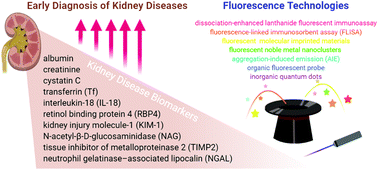Detection of kidney disease biomarkers based on fluorescence technology
Abstract
Screening for kidney diseases is of vital importance due to their current prevalence worldwide. The diagnosis and monitoring of kidney diseases rely on kidney disease biomarkers (KDBs), which include traditional KDBs such as serum creatinine and proteinuria as well as novel biomarkers such as kidney injury molecule-1 (KIM-1), neutrophil gelatinase-associated lipocalin (NGAL), N-acetyl-β-D-glucosaminidase (NAG), cystatin C, etc. The latter has been highly recognised for early and accurate diagnosis of kidney disease in the past decades. Fluorescence techniques have recently drawn considerable attention in the area of biomedicine due to the merits of high sensitivity, rapidity and cost efficiency. The combination of fluorescence technologies and KDBs has been proven by many studies to be a promising strategy for the prediction of kidney disease. Thus, in this review, we summarize recent advances of fluorescence technologies applied in the detection of traditional and novel KDBs. Due to the space limit, we focus on four traditional KDBs and eight novel KDBs as representatives. The design of fluorescent molecules, establishment of detection assays, and sensing mechanism of fluorescent probes are discussed in detail. Finally, future challenges and opportunities in this field are also analyzed. Through this review, we hope to inspire the discovery of novel fluorescence techniques with excellent performance in the early diagnosis of kidney diseases.

- This article is part of the themed collections: 2021 Materials Chemistry Frontiers Review-type Articles and Luminogenic bioprobes for personal health technologies


 Please wait while we load your content...
Please wait while we load your content...